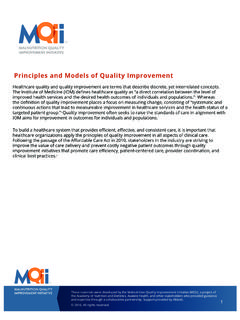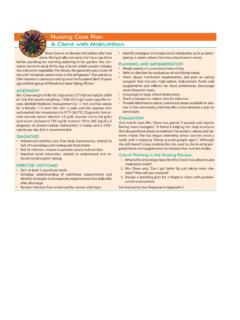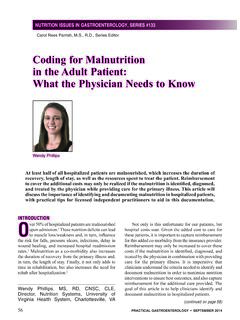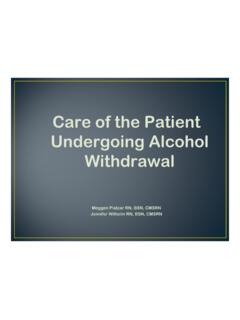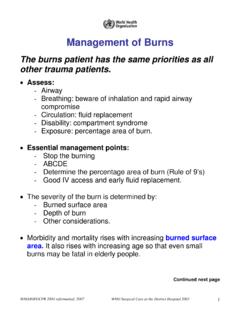Transcription of NURSING HOME CHARTING TIPS: A LEGAL PERSPECTIVE
1 NURSING HOME CHARTING TIPS: A LEGAL PERSPECTIVE Andrew Kopon, Jr. Michael A. Airdo P. Patrick Cella Kopon Airdo, LLC 233 South Wacker Drive, Suite 4450 Chicago, Illinois 60606 p f 2012 Kopon Airdo, LLC 2012 Kopon Airdo, LLC 2 NURSING Home CHARTING and Documentation The health care industry, including NURSING homes, has long been a target for litigation in America. In fact, in many states, including Illinois, there are laws designed to encourage private civil suits against NURSING homes by shifting the responsibility for the plaintiff s attorneys fees to the defendant NURSING home. All health care providers have a duty to provide appropriate care to their patients/residents. Of course, even with the best care provided, NURSING home residents become ill, fall, develop infectious diseases, and even die.
2 In many cases, residents, and/or their families, blame the NURSING home for causing the resident s injury or death. NURSING homes provide a valuable service for some of the most care -dependent individuals in our society. Because NURSING home residents are so vulnerable, and sometimes incapacitated, the care NURSING homes provide is often scrutinized with a suspicious eye. NURSING homes are expected to provide the same care that is generally accepted from similar NURSING homes within the same community. Therefore, a NURSING home will be measured against the standard of care established by NURSING homes in its own surrounding area, as well as those standards promulgated by the Federal Government and each State Government. In lawsuits filed against a NURSING home for the death or injury to a resident, residents often claim that the NURSING home negligently caused their injury, either by some affirmative action, or a failure to act.
3 The most common harms alleged in NURSING home lawsuits, include: falls, pressure ulcers and bed sores, dehydration and malnutrition, physical or verbal abuse, and medication errors. In essence, residents claim that the NURSING home had a duty to care for the resident and that the facility breached that duty, causing the resident s injury or death. The focus of almost all NURSING home cases is the resident s chart. Most of 2012 Kopon Airdo, LLC 3 the time, the best evidence to prove, and disprove, that the NURSING home breached its duty of care , lies within the resident s chart. The resident s chart is designed to be a complete and accurate record of the resident s care while at the facility. If something is missing from the chart, or is not clearly identified within the chart, the assumption is that it was never done.
4 Likewise, if it is documented and clearly identified within the resident s chart, there can be little dispute over the fact that the questioned care was provided absent contradictory evidence from another source. Whether a NURSING home was negligent will often be determined by what can be proved, or not proved, through careful examination of the resident s chart. Therefore, it is extremely important that NURSING facilities conform their documentation practices to a standard that ensures the accuracy and completeness of patient records. CHARTING in such a manner will ensure that NURSING facilities and their employees are protected if litigation occurs, but more importantly, it will allow facilities to provide the best possible care and treatment to its residents.
5 The recommendations that follow are offered as guidelines in formulating internal procedures and practices and should be reviewed by your own counsel and management team before implementation. General CHARTING Procedures and Practices The following procedures and practices are recommended for all NURSING facilities: Internal Procedures Follow Own Documentation Standards: Many facilities incorporate internal documentation procedures into the state-mandated CHARTING requirements. If these internal policies are not followed, they can, and will, be used against the NURSING home to show that the facility violated its own standard of care . As such, it is imperative that each and every staff member is familiar with the facility s own documentation standards and procedures. More importantly, every staff member who enters items in the chart must strictly adhere to the facility s own policies.
6 Every facility should employ quality assurance and quality 2012 Kopon Airdo, LLC 4 improvement systems or random checks to ensure that the facility s documentation procedures are being followed. Documentation Practices Legibility: While many NURSING facilities have moved to an electronic system of record-keeping, any handwritten records should be legible. Illegible documentation may interfere with the staff s ability in providing proper care and treatment to residents. Moreover, records that cannot be read are the equivalent of no record at all. Abbreviations: Although abbreviations are customarily used in the medical profession, they may be misinterpreted, ambiguous, or illegible. Therefore, only those symbols that are well known in the medical community and in the skilled care facility should be used.
7 Basic Information: It is quite possible that pages from a resident s chart may become separated from the chart. Therefore, the name of the resident and the resident s ID number should be placed on every page of the record, so that each page is readily identifiable in the event it is misplaced. Similarly, if a FIGURE 1: LEGIBILITY In the example on the left, all words are clearly written, including the medical abbreviation BP. In the example on the right, however, not only is the medical abbreviation BP unclear, it is also unclear what the BP actually is. This could be a catastrophic error, both for the resident and for the liability of the NURSING facility. 2012 Kopon Airdo, LLC 5 ST. MARY S NURSING HOME PROGRESS NOTES DATE/TIME 10-8-98 Alert, oriented x3. Lungs clear bilat. No SOB or resp @0800 distress noted VSS Afebrile Abd soft, nontender (BS(+) 4 quads.)
8 Continent of bowel & bladder. Tol. Meals fairly well. ADL S & transfers with assist. Gait fairly steady. Uses walker to amb (R) hip incision OTA & healing well. Pedal pulses (+) bilat. 2 + bilat pedal/ankle edema noted. c/o (L) shoulder discomfort esp. during PT/OT. Dr. Smith notified per physical therapist & will see pt. in AM ~ C. Wilson, RN 10-8-98 BP increase = 200/90. K. O Shannon notified. Orders @1600 Received & initiated ~ C. Wilson, RN 10-8-98 Pt. or x 3 c/o anxiety, lungs clear. Vasotin given for increase @2030 BP ~ P. Bera, Doe, Jane 087& F 11/01/1914 019566199 facility uses an electronic record-keeping system, any handwritten notes or records should be adequately referenced in the electronic record. From a LEGAL PERSPECTIVE , it is crucial to be able to use a resident s chart to prove that proper care was given, and that the standard of care was therefore met; a chart that contains the proper care documentation but lacks the resident s name cannot prove these things.
9 Moreover, missing pages from a chart demonstrates a lack of carefulness, destroying the facility s credibility. In addition, each entry in the chart should contain the day, month, and year the entry is made, along with the time of the entry. Furthermore, the author should sign each entry. Particular attention should be given to CHARTING documentations that continue from one page onto the next. The continuing entry must be re-dated and signed on the following page, as well as the page where the initial entry began. For example, the chart should conform to Figure 2 below. FIGURE 2 2012 Kopon Airdo, LLC 6 Specific and Substantive Terminology: Vague terminology fails to effectively communicate the resident s condition. For example: Resident reports that she is feeling better today, is not very informative and has little substance.
10 A more effective entry might read, Resident reports less pain in her right leg. She has eaten a full breakfast and is fully ambulatory. Correcting Documentation Errors: Entries in a resident s record should never be erased, obliterated, altered with corrective fluid, or otherwise deleted. The inference that may be drawn from a correction that is erased or unreadable is that the entry is, or was, damaging to the facility. Therefore, each individual facility should have procedures in place for correcting documentation errors, and every staff member should be made aware of the facility s internal procedures for correcting errors. The general practice in correcting handwritten chart errors is to draw a single line through the entry to allow a subsequent reader to interpret the lined-out entry.
